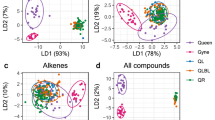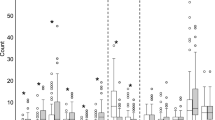Abstract
Queens and workers are not morphologically differentiated in the primitively eusocial wasp, Ropalidia marginata. Upon removal of the queen, one of the workers becomes extremely aggressive, but immediately drops her aggression if the queen is returned. If the queen is not returned, this hyper-aggressive individual, the potential queen (PQ), will develop her ovaries, lose her hyper-aggression, and become the next colony queen. Because of the non-aggressive nature of the queen, and because the PQ loses her aggression by the time she starts laying eggs, we hypothesized that regulation of worker reproduction in R. marginata is mediated by pheromones rather than by physical aggression. Based on the immediate loss of aggression by the PQ upon return of the queen, we developed a bioassay to test whether the queen’s Dufour’s gland is, at least, one of the sources of the queen pheromone. Macerates of the queen’s Dufour’s gland, but not that of the worker’s Dufour’s gland, mimic the queen in making the PQ decrease her aggression. We also correctly distinguished queens and workers of R. marginata nests by a discriminant function analysis based on the chemical composition of their respective Dufour’s glands.



Similar content being viewed by others
References
Bhadra, A., Iyer, P. L., Sumana, A., Deshpande, S. A., Ghosh, S., and Gadagkar, R. 2007. How do workers of the primitively eusocial wasp Ropalidia marginata detect the presence of their queens? J. Theor. Biol. 246: 574–582.
Dapporto, L., Santini, A., Dani, F. R., and Turillazzi, S. 2007. Workers of a Polistes paper wasp detect the presence of their queen by chemical cues. Chem. Senses 32: 795–802. doi:10.1093/chemse/bjm047.
Deshpande, S. A., Sumana, A., Surbeck, M., and Gadagkar, R. 2006. Wasp who would be queen: A comparative study of two primitively eusocial species. Curr. Sci. 91: 332–336.
Dor, R., Katzav-Gozansky, T., and Hefetz, A. 2005. Dufour’s gland pheromone as a reliable fertility signal among honeybee (Apis mellifera) workers. Behav. Ecol. 49: 401–409.
Downing, H. A. 1991. A role of the Dufour's gland in the dominance interactions of the paper wasp, Polistes fuscatus (Hymenoptera: Vespidae). J. Insect Behav. 4: 557–565.
Gadagkar, R. 2001. The Social Biology of Ropalidia marginata: Toward Understanding the Evolution of Eusociality. Harvard University Press, Cambridge.
Kardile, S. P., and Gadagkar, R. 2002. Docile sitters and active fighters in paper wasps: a tale of two queens. Naturwissenschaften 89: 302–304. doi:10.1007/s00114-002-0306-2.
Katzav-Gozansky, T., Soroker, V., and Hefetz, A. 1997. Plasticity of caste specific Dufour’s gland secretion in the honey bee (Apis mellifera L.). Naturwissenschaften 84: 238–241.
Katzav-Gozansky, T., Soroker, V., and Hefetz, A. 2002. Evolution of worker sterility in honey bees: egg-laying workers express queen-like secretion in Dufour’s gland. Behav. Ecol. Sociobiol. 51: 588–589.
Keller, L., and Nonacs, P. 1993. The role of queen pheromones in social insects: queen control or queen signal? Anim. Behav. 45: 787–794.
Krebs, C. J. 1989. Ecological Methodology. Harper & Row, New York.
Premnath, S., Sinha, A., and Gadagkar, R. 1996. Dominance relationships in the establishment of reproductive division of labour in a primitively eusocial wasp (Ropalidia marginata). Behav. Ecol. Sociobiol. 39: 125–132, doi:10.1007/s002650050274.
Reyment, R. A. 1989. Compositional data analysis. Terra Nova. 1: 29–34.
Shannon, C. E. 1948. A mathematical theory of communication. The Bell Syst. Tech. J. 27: 379–423 & 623–656.
Sledge, M. F., Boscaro, F., and Turillazzi, S. 2001. Cuticular hydrocarbons and reproductive status in the social wasp Polistes dominulus. Behav. Ecol. Sociobiol. 58: 270–276.
Sumana, A., and Gadagkar, R. 2003. Ropalidia marginata—a primitively eusocial wasp society headed by behaviourally non-dominant queens. Curr. Sci. 84: 1464–1468.
Sumana, A., Deshpande, S. A., Bhadra, A., and Gadagkar, R. 2007/2008. Workers of the primitively eusocial wasp Ropalidia marginata do not perceive their queen across a wire mesh partition. J. Ethol. 26: 207–212. doi:10.1007/s10164-007-0049-9.
Wilson, E. O. 1971. The Insect Societies. The Belknap Press of Harvard University Press, Cambridge.
Zar, J. H. 1999. Biostatistical Analysis. Pearson Education Inc., Tan Prints Private Ltd., India.
Acknowledgements
We thank the Department of Science and Technology, the Department of Biotechnology, the Council for Scientific and Industrial Research and the Ministry of Environment and Forests, Government of India for financial assistance, and Robin Crewe for helpful comments and encouragement. We also thank Anjali Rajasekharan, Pooja Muralidharan and Gautam Pramanik, Centre for Ecological Sciences, Indian Institute of Science, Bangalore, for technical assistance with the GC-MS analyses and, Prasanta Das, Department of Inorganic and Physical Chemistry, Indian Institute of Science, Bangalore, for providing useful suggestions regarding interpretation of mass spectra. AB carried out the behavioral observations. SAD, KC, and AM did the dissections and prepared the extracts. AM carried out the chemical analysis, with help and guidance from DGN and AH. The paper was co-written by AB, AM, and RG, and RG supervised the overall work. All experiments reported here comply with the current laws of the country in which they were performed.
Author information
Authors and Affiliations
Corresponding author
Electronic Supplementary Materials
Below is the link to the electronic supplementary material.
Supplementary material S1
Flame ionization detection gas chromatogram of a Ropalidia marginata Dufour’s gland crushed in Ringer’s solution, evaporated to dryness and resuspended in pentane. Asterisk signifies contaminant from Ringer’s solution. Identities of peak numbers are given in Table 1. Compare the chromatogram of this extraction method with that obtained in S2 (PDF 34 kb)
Supplementary material S2
Comparison of gas chromatograms of the same sample of a Ropalidia marginata Dufour’s gland extracted in pentane and analyzed by flame ionization detection (FID) and mass spectrometry (total ion chromatogram; TIC). Identities of peak numbers are given in Table 1 (PDF 188 kb)
Supplementary material S3
Flame ionization detection gas chromatogram of a Ropalidia marginata Dufour’s gland crushed and extracted in acetone. Identities of peak numbers are given in Table 1. Compare the chromatogram of this extraction method with that obtained in S2 (PDF 19 kb)
Rights and permissions
About this article
Cite this article
Bhadra, A., Mitra, A., Deshpande, S.A. et al. Regulation of Reproduction in the Primitively Eusocial Wasp Ropalidia marginata: on the Trail of the Queen Pheromone. J Chem Ecol 36, 424–431 (2010). https://doi.org/10.1007/s10886-010-9770-x
Received:
Revised:
Accepted:
Published:
Issue Date:
DOI: https://doi.org/10.1007/s10886-010-9770-x




